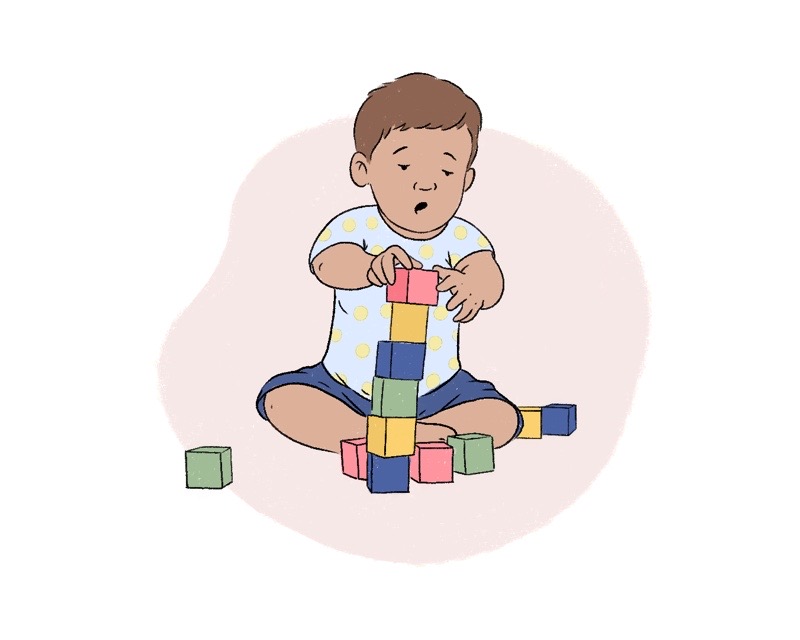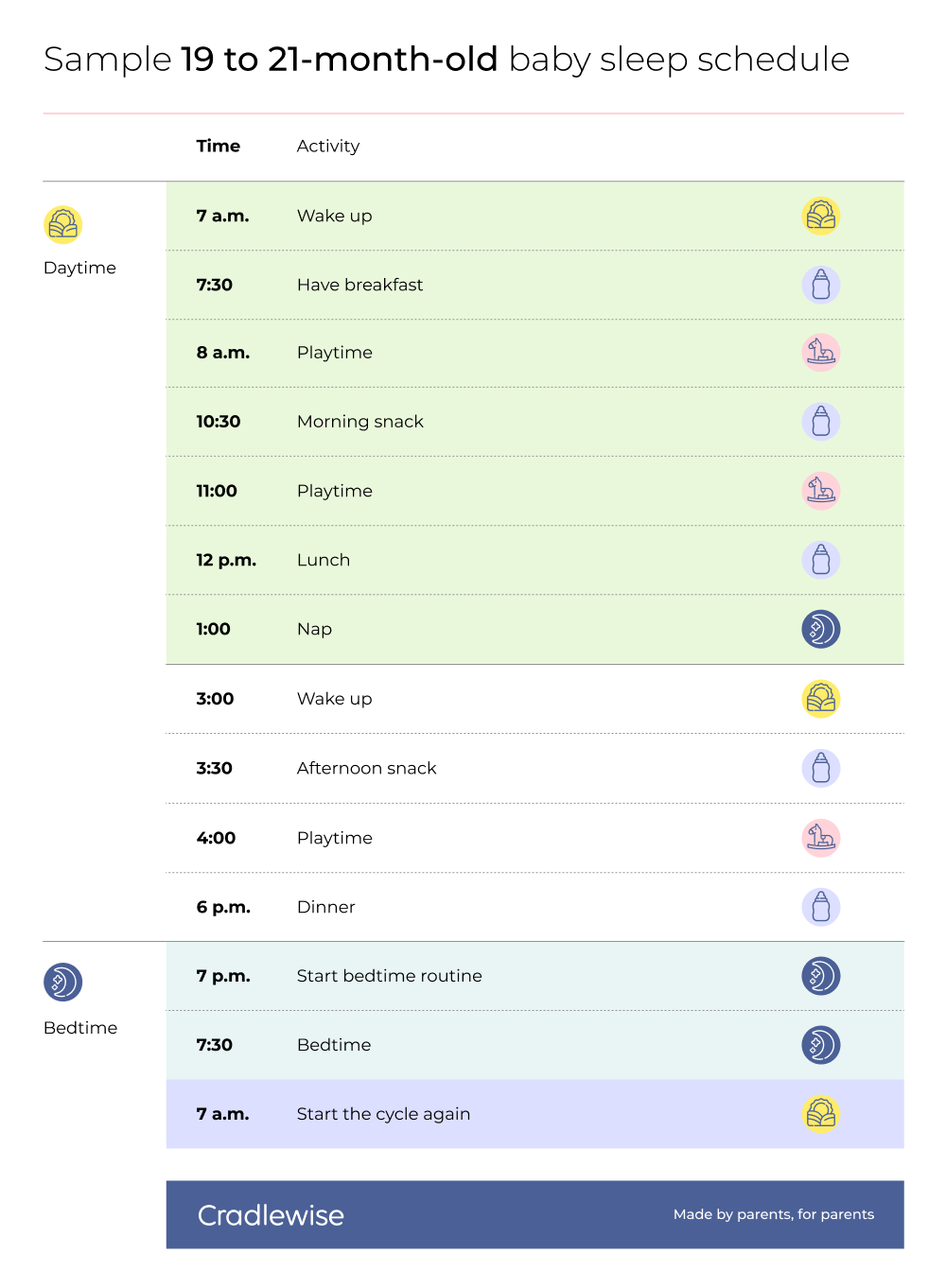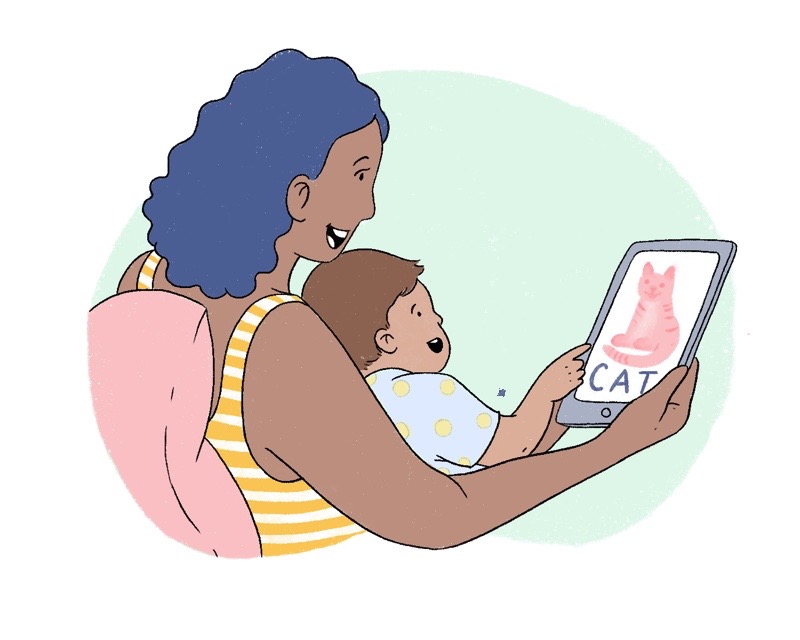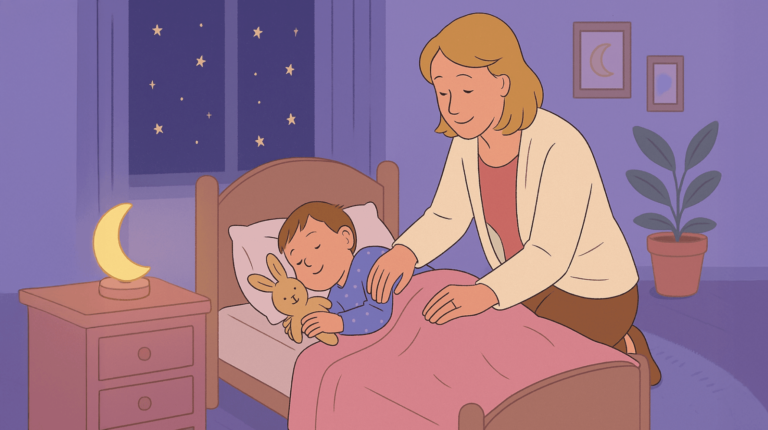
Night sleep
11 hours

Daytime naps
2-3 hours

Total sleep
11-14 hours
Can you believe your little one is fast approaching their second birthday? The baby-to-toddler transition happens fast—and it doesn’t seem to show any signs of slowing down. 😭
Along with new physical and developmental changes that might seem to crop up every day, you may also notice some changes in your toddler’s sleep habits.
For example, it may be increasingly difficult to get your toddler to go to sleep at bedtime. Who can blame them, when there’s so much to explore?
Fortunately, there are things you can do to promote healthy sleep habits in your toddler—or restore sleep habits that may have backslid a bit over the past couple of months.
Keep reading for more details about what to expect with your toddler’s sleep between 19 and 21 months of age, along with milestones, nutrition needs, and more.
19-21 month-old toddler milestones for sleep
Around 19 months old, your toddler has most likely transitioned to one daily nap from two naps.
However, if your toddler is still enjoying two naps per day, feel free to enjoy this for as long as it feels right for both of you. Every child is different and while most toddlers do start to transition to one nap before age two, yours might need more time and that’s okay.
A common bedtime theme for your 19-21-month-old could be difficulty in winding down enough to go to sleep. At this age, they’re just having too much fun to want to stop playing and go to bed.
They may also experience overtiredness that looks like hyperactivity, when it’s actually a sign of fatigue.
To help combat both scenarios, build in extra decompression time before bed and give yourself plenty of time to complete your bedtime routine together.
The good news is, you might get a break from sleep regressions during this time period, so enjoy it while it lasts!
What’s going on in your toddler’s brain?

Sleep is essential for your toddler’s overall health, including meeting other developmental milestones.
But what exactly are those developmental milestones happening in your toddler’s brain from 19 to 21 months?
According to the Centers for Disease Control and Prevention (CDC), some of the milestones you will begin to see as your toddler approaches their second birthday include:
- Jumping
- Running
- Some climbing
- Kicking a ball
- Using the stairs, with help or without
- Sorting shapes and colors
- Drawing marks on paper
- Stacking blocks
- Using two words together, such as “Want milk”
- Naming objects, including some body parts
How much should a 19-21-month-old sleep?
The total amount of time that your toddler sleeps during 24 hours stays relatively consistent from about age 1 to 3 years. The number of naps may change from two naps to one nap as your toddler gets older.
According to the CDC, your toddler needs a total of 11 to 14 hours of sleep each day, including nighttime sleep and naps.
- Total hours of sleep: 11 to 14 hours
- Wake windows: 5-6 hours
- Number of naps: 1-2 naps
Sample sleep schedule for a 19-21-month-old toddler
Below is a sample daily schedule for your 19- to 21-month-old toddler.
Many children between the ages of 19 and 21 months will wake up around 7 AM or a little after, according to the Journal of Sleep Research.
However, if you cannot imagine your toddler sleeping in until 7 AM, you are not alone! There is plenty of room for variation here.


19-21 month-old feeding tips

A healthy diet for a toddler between the ages of 19-21 months will consist of a variety of foods—your toddler may start to become more selective with the foods they will eat, and that’s normal.
Just continue to offer a variety of healthy and nutritious options.
If you have been breastfeeding your toddler, you can continue to nurse as long as you both wish.
The American Academy of Pediatrics has issued a statement in support of continued breastfeeding, if desired by both caregiver and toddler, until age 2 and even beyond.
However, even for breastfeeding babies, a healthy diet will incorporate other foods and beverages with breast milk.
Mealtimes are important growth opportunities for children. Not only can your family spend time together eating, but toddlers can also practice their motor skills by feeding themselves. (Just don’t forget to account for the extra clean-up this might entail, ahem.)
The good news is that it is not necessary to prepare a special meal for your 19-21-month-old.
Foods that are healthy for the entire family, such as fresh fruits and vegetables, lean protein, and whole grains, are good for your toddler too.
The primary beverage offered to your toddler should be milk or water. Avoid sugar-sweetened beverages such as juice as much as possible, and limit juice to just 100%, and just 4 ounces per day.
- How much should a 19-21-month-old eat? According to the American Academy of Pediatrics, toddlers between one and three years of age need about 1,000 calories per day.
It is also important to not restrict fat from your toddler’s diet, as fats are essential for their development. About half of their calories should come from fat.
- How much should a 19-21-month-old weigh? According to World Health Organization growth charts:
- 23 pounds, for 19-month-old girls in the 50th percentile for weight
- 24 pounds, for 21-month-old girls in the 50th percentile for weight
- 24.5 pounds, for 19-month-old boys in the 50th percentile for weight
- 25 pounds, for 21-month-old boys in the 50th percentile for weight
- How often should a 16- to 18-month-old eat? Ideally, the 1,000 calories your toddler eats in a day is divided into three meals and two snacks per day.
Every child and every meal are different though, so be sure to offer your child a variety of food choices.
Encourage your child to eat, but do not worry if they eat more during one meal or day and then less during the next meal or the next day, as toddlers are known for their irregular eating habits.
How to help support your toddler’s sleep during 19-21 months

1. Make time for active play during the day
Encouraging active play during the day could help improve your toddler’s sleep at night. Higher levels of physical activity in toddlers have been associated with longer total sleep duration, improved sleep quality, and more stable sleep. Plus, as you’ve probably picked up by now, being active comes very naturally to many toddlers. Just be careful to offer plenty of time near bedtime to “come down” from all that activity to prepare for sleep.
2. Consider making bedtime earlier
You may worry that putting your toddler to bed earlier will just cause them to wake up earlier in the morning, but research has demonstrated that an earlier bedtime could help your child sleep longer.
In fact, the time that you put your child to bed is not necessarily correlated with what time they will wake up, since what time we wake up is associated with our natural circadian rhythm—that’s why parents are often all-too familiar with the dreaded reality that putting a toddler down to bed late can still mean a bright-and-early morning for everyone!
3. Be careful with screen time
We have good news and bad news about screen time. The good news is that the American Academy of Pediatrics (AAP) has stated that children can be introduced to screen time after the age of 18 months. They specifically recommend parents use digital media along with their children.
The bad news is that both total daily screen time and evening screen time are associated with worse sleep outcomes, including shorter total sleep duration and a later bedtime in toddlers. If you are going to introduce your child to screens (and let’s be honest, who isn’t?), try to use the screens earlier in the day along with your child, and stick to educational programming and apps only.
4. Limit time in bed for sleep only
You have likely heard this tip for adults, but it applies to children as well! The bed should only be used for sleep or parts of the bedtime routine, such as reading. That way, children are not confused by when it is time to sleep and when it is time to play.
And as a reminder, don’t forget that bedtime routine when it is time for sleep. Research has also shown that the more nights per week that the bedtime routine is followed, the greater the improvements in sleep outcomes for both children and caregivers.
5. Set the scene for bedtime
Adjust your child’s room if possible to facilitate a relaxing bedtime. Rather than using a large overhead light to read by, try using a bedside lamp or even a small reading light on the book. If the room gets a lot of natural light, try using blackout curtains, especially during the time of year when it might still be light outside when it is time to go to bed. Turning on a fan or turning the thermostat down slightly may also help your child snuggle into bed. Make sure your toddler has their favorite comfort item as well for a good night.
More posts you might like:
Sources:
- The one-nap transition. 2023. Cradlewise. How do you know when a baby is ready to drop to one nap? 6 tell-tale signs.
- 24-month-old milestones. Centers for Disease Control and Prevention. Important Milestones: Your Baby By Two Years.
- Sleep recommendations for infants and toddlers. 2023. Centers for Disease Control and Prevention. How Much Sleep Do I Need?
- Toddler wake times. 2016. Journal of Sleep Research. Development of infant and toddler sleep patterns: real-world data from a mobile application.
- Breastmilk recommendations. 2022. American Academy of Pediatrics. Policy Statement: Breastfeeding and the Use of Human Milk.
- Beverages for toddlers. 2018. American Family Physicians. Nutrition in Toddlers.
- Family mealtime. 2021. American College of Pediatricians. The Benefits of the Family Table.
- Feeding your one-year-old. 2022. Centers for Disease Control and Prevention. Feeding & Nutrition Tips: Your 1-Year-Old.
- Toddler nutrition. 2021. American Academy of Pediatrics. Toddler Food and Feeding.
- Toddler hydration. 2020. American Academy of Pediatrics. Choose Water for Healthy Hydration.
- Average height and weights for toddlers. 2009. HealthyChildren.org. Physical Appearance and Growth: Your 1-Year-Old.
- Feeding tips for toddlers. 2022. HealthyChildren.org. Feeding & Nutrition Tips: Your 2-Year-Old.
- Screen time and sleep. 2020. Sleep Medicine Reviews. Associations of screen time, sedentary time and physical activity with sleep in under 5s: A systematic review and meta-analysis.
- Sleep duration in children. 2020. JAMA Pediatrics. Nonpharmacological Interventions to Lengthen Sleep Duration in Healthy Children: A Systematic Review and Meta-analysis.
- Bedtime routine. 2018. Sleep Medicine Reviews. Benefits of a bedtime routine in young children: Sleep, development, and beyond.
- Screentime recommendations for toddlers. 2022. American Academy of Pediatrics. Where We Stand: Screen Time.




